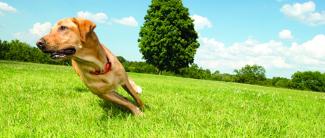Hardworking sporting dogs benefit from higher proportions of fat in their diet. Why? Because, a dog’s metabolism relies primarily on fat for energy during rest and light to moderate intensity exercise. Ingesting higher levels of fat in the diet actually “primes” or “metabolically conditions” an active dog’s metabolism, even when not active or exercising1. So while a greater proportion of fat in the diet helps to deliver more calories to an exercising dog, another important benefit is that it helps to optimize a dog’s metabolism.
Maximum efficiency comes from a diet containing highly digestible fat2. A diet that skimps on fat will contribute to a reduction in endurance and overall fitness. Fat is more energy dense compared to carbohydrates and protein, and when the dietary fat concentration is increased in a food, the food’s energy density gets a boost. An energy dense food is important when more calories are needed, thus less food to be eaten to provide the greater energy required to maintain a stable body weight and an active lifestyle.
A visible effect in dogs that receive a diet lacking adequate fat is a dull, scruffy coat and flaky skin. Fat contains the omgea-6 fatty acid, linoleic acid, which is important in the fat portion of skin cells, called epidermal cells. A proper balance of linoleic acid in skin cell membranes helps maintain the epidermal water barrier, which promotes healthy skin and coat.
Fat has many other benefits as well. It slows down the rate of stomach emptying, giving dogs a feeling of fullness after meals. Fat is important for the absorption and digestion of fat-soluble vitamins – A, D, E and K – that depend on dietary fat and normal fat absorption for their uptake and utilization in the body. Fatty acids help regulate the inflammation process via a proper immune response.
Fat deposits under the skin, around the vital organs and in membranes surrounding the intestines provide energy when needed and storage when there is a surplus. Fat under the skin provides insulation from temperature extremes and fat surrounding organs cushions and protects from physical shock. Lastly, fat is highly palatable and contributes to the texture of dog food3.
Active dogs need fat to fuel their muscles and make the energy they require for movement. Dogs fed a high-fat food have more capacity to burn fatty acids and a greater capacity to perform at a high level. Purina Pro Plan formulated its Purina Pro Plan Sport dog food formulas with high levels of fat to give dogs an increased amount of this energy-dense nutrient needed for exercise or work.
Factoid
Fat metabolism is the optimal energy-generating process for exercising dogs. The body is in a more optimal state of fat burning when fed 18 to 24 hours before exercise compared to only 4-6 hours before exercise. This is why dogs should be fed a full meal a minimum of 10 to 12 hours before exercise and up to 20 to 24 hours.
Did you know, unlike humans, your dog’s main energy source comes from fat, not carbohydrates, during rest and most types of exercise?
To learn more about the important role of fat in dogs’ diets, you may check out the reference articles above as well as these articles.
- Bauer JE, Heinemann KM, Waldron MK. Recent Studies on Omega-3 Fatty Acid Effects in Canine Species. Proceedings of the 2006 Nestlé Purina Nutrition Forum. Lausanne, Switzerland.
- Hester SL, Kirby NA, Wright AS, et al. Effect of Dietary Polyunsaturated Fatty Acids and Zinc on Plasma Lipids and Skin and Hair Coat Condition in Canines. Proceedings of the 2005 Nestlé Purina Nutrition Forum. St. Louis, MO. (Abstract)
- Altom EK, Cummins KA, Myers LL, et al. Endocrine Responses to Dietary Fat and Physical Conditioning in Canine Athletes During Treadmill Exercise. Proceedings of the 1998 Nestlé Purina Nutrition Forum. St. Louis, MO.
- Anderson RJ, Lusk G. Animal Calorimetry: The Interrelation Between Diet and Body Condition and the Energy Production During Mechanical Work. Journal of Biological Chemistry. 1917;32.3:421-445.
- Young DR, Iacovino A, Erve P, Mosher R, Spector H. Effect of Time After Feeding and Carbohydrate or Water Supplement on Work in Dogs. Journal of Applied Physiology. 1959;14:1013-1017.
- Cerretelli P, Piiper J, Mangili F, Ricci B. Aerobic and Anaerobic Metabolism in Exercising Dogs. Journal of Applied Physiology. 1964;19:25-28.
- Wagner JA, Horvath SM, Dahms TE. Cardiovascular, Respiratory and Metabolic Adjustments to Exercise in Dogs. Journal of Applied Physiology. 1977;42(3):403-407.
1 Reynolds AJ, Fuhrer L, Dunlop HL, Finke MD, Kallfelz FA. Lipid metabolite responses to diet and training in sled dogs. J. Nutr. 1994. 124:2754S-2759S.
2 Grandjean D, Paragon BM. Nutrition of Racing and Working Dogs. Part II: Determination of Energy Requirements and the Nutritional Impact of Stress. The
Compendium of Continuing Education for the Practicing Veterinarian. 1993;15:45.
3 Case LP, Carey DP, Hirakawa DA. Canine and Feline Nutrition: A Resource for Companion Animal Nutrition Professionals. Mosby, St. Louis, MO. 1995: 22-24.

